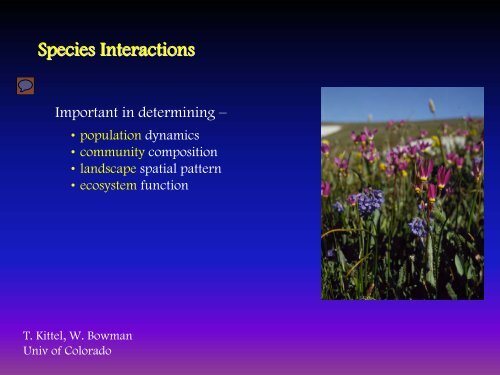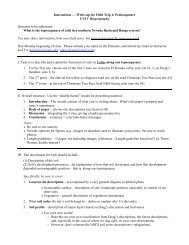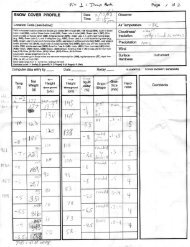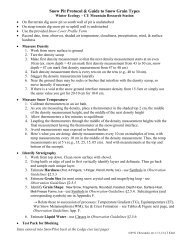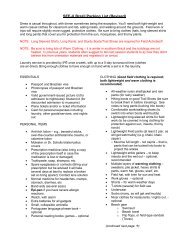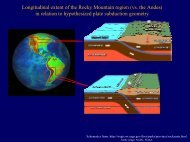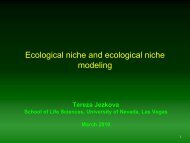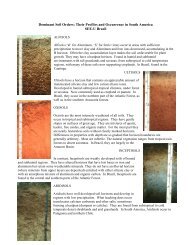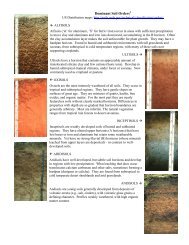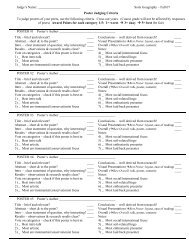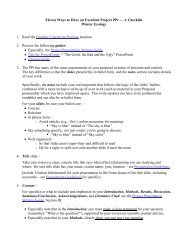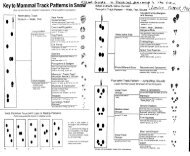Species Interactions
Species Interactions
Species Interactions
Create successful ePaper yourself
Turn your PDF publications into a flip-book with our unique Google optimized e-Paper software.
<strong>Species</strong> <strong>Interactions</strong><br />
Important in determining –<br />
• population dynamics<br />
• community composition<br />
• landscape spatial pattern<br />
• ecosystem function<br />
T. Kittel, W. Bowman<br />
Univ of Colorado
General Categories<br />
Assigned by effect on the two individual organisms interacting:<br />
+, + = mutualism N 2 fixation, mycorrhizae<br />
+, 0 = commensalism Nurse plants<br />
–, 0/+= amensalism Allelopathy<br />
–, + = parasitism<br />
herbivory / predation<br />
–, – = competition Intra & interspecific<br />
Think about these interactions in the context of species geography!<br />
Can be more complicated than direct interactions of 2 individuals<br />
mediated through a 3 rd individual or species<br />
• soil microbes, herbivores influence competitive interactions
A. Mutualism (+, +)<br />
Plant-Microbe<br />
• Mycorrhizae<br />
• N–fixation<br />
• Lichen<br />
Plant-Animal<br />
• Pollination<br />
• Insects<br />
• Birds<br />
• Hummingbirds<br />
• Bats<br />
Mucuna holtonii, Central America<br />
Rhinoceros Hornbill eating<br />
Strangler Fig fruits, Borneo<br />
• Fruit dispersal<br />
• Defense<br />
• Ants<br />
Azteca Ants on Cecropai, Panama
Arizona-Sonoran Desert Museum<br />
www.desertmuseum.org/pollination/<br />
Rufous Hummingbird<br />
“The Forgotten Pollinators”<br />
Long–distance migratory pollinators<br />
• Threatened – habitat loss<br />
• Keystone species<br />
Lesser Long-nosed Bat<br />
“Nectar corridors”<br />
• Sequence of flowering plants<br />
Monarch Butterfly<br />
White-winged Dove
B. Commensalism (+,0)<br />
Plant-Plant<br />
1) Vines<br />
2) Epiphytes<br />
• Bromeliads<br />
• Orchids<br />
• Cacti<br />
• Ferns<br />
• Lichen<br />
• Moss<br />
• Algae<br />
moss v. lichen<br />
Atlantic Forest, Brazil<br />
Staghorn fern
Exceptions – Commensalism goes<br />
to Mutualism –<br />
Lichen with cyanobacteria: N<br />
leaching, benefit to tree<br />
goes bad –<br />
Detrimental overburden<br />
Competition<br />
• Strangulation<br />
• Overtopping<br />
Strangler fig
Kudzu<br />
– “the vine that ate the south”<br />
• Introduced 1876 from Asia<br />
• Planted for soil conservation 1930’s<br />
Pueraria montana var. lobata<br />
Oriental Bittersweet<br />
Celastrus orbiculata<br />
• Vine, introduced from e. Asia<br />
• Invasion in eastern US
A. Commensalism – continued<br />
2) Nurse plants<br />
• Saguaros under Palo Verde<br />
• Desert annuals under shrubs<br />
• Piñon pine under Sagebrush
Plant-animal commensalism –Habitat<br />
• nesting<br />
• roosting<br />
• hunting for other animals<br />
• shelter from other animals<br />
Red-footed Booby in Mangrove<br />
Galápagos Is.<br />
Oropendola nests, Roraima Brazil<br />
Iran Jaya's People of the Trees<br />
Titi monkey, São Paulo Brazil
C. Amensalism (– , 0/+)<br />
Allelochemical <strong>Interactions</strong><br />
• Plant–Plant<br />
• Allelopathy<br />
Difficult to show in field<br />
Larrea tridentata - Creosote<br />
• Plant–Animal<br />
• Herbivory defenses<br />
Big sagebrush with<br />
native bunchgrasses growing under<br />
canopy<br />
• Plant–Decomposer<br />
• Litter composition soil pH soil biota:<br />
Conifer low pH fungi favored,<br />
Temperate Deciduous neutral bacteria<br />
• Plant leakage of compounds detrimental to soil biota
D. Parasitism (–,+)<br />
Dodder (Cuscuta) –<br />
• stem parasite<br />
• no chlorophyll = holoparasite
Coral root orchid - Corallarhiza maculata<br />
root parasite on pines
Arceuthobium americanum<br />
Carpellate plant on Pinus contorta<br />
Mistletoe –<br />
• stem parasite<br />
• differing degrees of chlorophyll<br />
• with chlorophyll = hemiparasite<br />
• w/o holoparasite<br />
Dwarf mistletoe – holoparasite<br />
Arceuthobium cyanocarpum<br />
Staminate plant (left) and carpellate plant (right)<br />
on Pinus ponderosa
Broadleaf (Hairy) mistletoe - hemiparasite<br />
Phoradendron tomentosum<br />
on hackberry (Celtis laevigata), preferred host
More hemiparasites:<br />
• Indian paintbrush – Castilleja spp.<br />
• Root parasite
Inference of species interactions on the landscape<br />
• If species interactions are important to plant species – Should be reflected in<br />
the spatial patterns of individuals (inter and intraspecific)<br />
• if mutualisms among plant species occur, should be a positive association<br />
they should occur closer together (clumped)<br />
than predicted by chance (random)
Landscape spatial patterning (con’t)<br />
• if amensalism occurs, should be pushed away from each other<br />
giving an even distribution<br />
Larrea tridentata - Creosote
Landscape spatial patterning (con’t)<br />
• Under competition – competitive exclusion leads to<br />
• range separation<br />
• niche partitioning<br />
Non-overlapping geographic ranges of five<br />
species of large kangaroo rats
Within–canopy distribution<br />
Amazonian tree –<br />
The long roots dangling from the crown<br />
probably belong to Philodendrons<br />
On the middle and upper branches<br />
cluster groups of orchids, bromeliads,<br />
and ferns – including staghorn fern<br />
Low on the trunk are Arums &<br />
Philodendrons with heart-shaped leaves
Keystone species<br />
• Presence of a species determines community structure<br />
disproportionately to population size
Summary – <strong>Species</strong> <strong>Interactions</strong><br />
‣ Plants and animals engaged in interactions with wide range of<br />
other taxa<br />
‣ Positive, detrimental, or neutral effects of one species on another<br />
‣ Reflected in spatial patterns – random vs. even vs. uniform<br />
‣ Reflected in community structure – Keystone species


